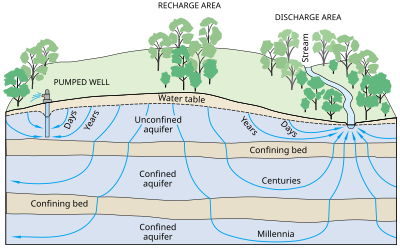
Back Acuifero AN طبقة المياه الجوفية Arabic آکیفر AZB Водоносен хоризонт Bulgarian ভূগর্ভস্থ সিক্ত শিলাস্তর Bengali/Bangla Aqüífer Catalan ئاوھەڵگر CKB Zvodeň Czech Grundvandsmagasin Danish Grundwasserleiter German

An aquifer is an underground layer of water-bearing material, consisting of permeable or fractured rock, or of unconsolidated materials (gravel, sand, or silt).[1] Aquifers vary greatly in their characteristics. The study of water flow in aquifers and the characterization of aquifers is called hydrogeology. Related terms include aquitard, which is a bed of low permeability along an aquifer, and aquiclude (or aquifuge), which is a solid, impermeable area underlying or overlying an aquifer, the pressure of which could lead to the formation of a confined aquifer. The classification of aquifers is as follows: Saturated versus unsaturated; aquifers versus aquitards; confined versus unconfined; isotropic versus anisotropic; porous, karst, or fractured; transboundary aquifer.
Groundwater from aquifers can be sustainably harvested by humans through the use of qanats leading to a well.[2] This groundwater is a major source of fresh water for many regions, however can present a number of challenges such as overdrafting (extracting groundwater beyond the equilibrium yield of the aquifer), groundwater-related subsidence of land, and the salinization or pollution of the groundwater.
- ^ "Wikiwand - Aquifer". Wikiwand. Retrieved 2024-06-27.
- ^ Walker, Kira (2022). "Ancient systems keep water flowing". Nature Middle East. Nature. doi:10.1038/nmiddleeast.2022.72. S2CID 253486495. Retrieved 10 July 2023.
© MMXXIII Rich X Search. We shall prevail. All rights reserved. Rich X Search